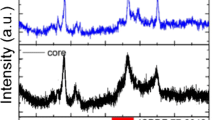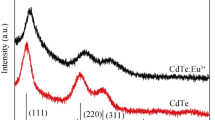Abstract
The design of nanostructured materials with highly stable water-dispersion and luminescence efficiency is an important concern in nanotechnology and nanomedicine. In this paper, we described the synthesis and distinct surface modification on the morphological structure and optical (optical absorption, band gap energy, excitation, emission, decay time, etc.) properties of highly crystalline water-dispersible CaF2:Ce/Tb nanocrystals (core-nanocrystals). The epitaxial growth of inert CaF2 and silica shell, respectively, on their surface forming as CaF2:Ce/Tb@CaF2 (core/shell) and CaF2:Ce/Tb@CaF2@SiO2 (core/shell/SiO2) nanoarchitecture. X-ray diffraction and transmission electron microscope image shows that the nanocrystals were in irregular spherical phase, highly crystalline (~20 nm) with narrow size distribution. The core/shell nanocrystals confirm that the surface coating is responsible in the change of symmetrical nanostructure, which was determined from the band gap energy and luminescent properties. It was found that an inert inorganic shell formation effectively enhances the luminescence efficiency and silica shell makes the nanocrystals highly water-dispersible. In addition, Ce3+/Tb3+-co-doped CaF2 nanocrystals show efficient energy transfer from Ce3+ to Tb3+ ion and strong green luminescence of Tb3+ ion at 541 nm(5D4→7F5). Luminescence decay curves of core and core/shell nanocrystals were fitted using mono and biexponential equations, and R 2 regression coefficient criteria were used to discriminate the goodness of the fitted model. The lifetime values for the core/shell nanocrystals are higher than core-nanocrystals. Considering the high stable water-dispersion and intensive luminescence emission in the visible region, these luminescent core/shell nanocrystals could be potential candidates for luminescent bio-imaging, optical bio-probe, displays, staining, and multianalyte optical sensing.
Graphical Abstract
A newly designed CaF2:Ce/Tb nanoparticles via metal complex decomposition rout shows high dispersibility in aqueous solvents with enhanced photoluminescence. The epitaxial growth of inert CaF2 shell and further amorphous silica, respectively, enhanced their optical and luminescence properties, which is highly usable for luminescent biolabeling, and optical bioprobe etc.










Similar content being viewed by others
References
Zheng W, Tu D, Huang P, Zhou S, Chen Z, Chen X. Time-resolved luminescent biosensing based on inorganic lanthanide-doped nanoprobes. Chem Commun. 2015;51:4129–43.
Borisov SM, Wolfbeis OS. Optical biosensors. Chem Rev. 2008;108:423–61.
Yang YM, Zhao Q, Feng W, Li FY. Luminescent chemodosimeters for bioimaging. Chem Rev. 2013;113:192–270.
Vercoutere W, Akeson M. Biosensors for DNA sequence detection. Curr Opin Chem Biol. 2002;6:816–22.
Bunzli JCG. Benefiting from the unique properties of lanthanide ions. Acc Chem Res. 2006;39:53–61.
Zheng W, Zhou S, Chen Z, Hu P, Liu Y, Tu D, Zhu H, Li R, Huang M, Chen X. Sub-10 nm lanthanide-doped CaF2 nanoprobes for time-resolved luminescent Biodetection. Angew Chem Int Ed. 2013;52:6671–67.
Hao S, Yang L, Qiu H, Fan R, Yang C, Chen G. Heterogeneous core/shell fluoride nanocrystals with enhanced upconversion photoluminescence for in vivo bioimaging. Nanoscale. 2015;7:10775–80.
Hou S, Zou Y, Liu X, Yu X, Liu B, Suna X, Xing Y. CaF2 and CaF2:Ln3+ (Ln = Er, Nd, Yb) hierarchical nanoflowers: hydrothermal synthesis and luminescent properties. Cryst Eng Comm. 2011;13:835–40.
Mao Y, Zhang F, Wong SS. Ambient template-directed synthesis of single-crystalline alkaline-earth metal fluoride nanowires. Adv Mater. 2006;18:1895–9.
Zhou B, Tao L, Tsang YH, Jin W. Core–shell nanoarchitecture: a strategy to significantly enhance white-light upconversion of lanthanide-doped nanoparticles. J Mater Chem C. 2013;1:4313–8.
Sarkar S, Hazra C, Mahalingam V. Bright luminescence from colloidal Ln3+-doped Ca0.72Y0.28F2.28 (Ln= Eu, Tm/Yb) nanocrystals via both high and low energy radiations. Chem Eur J. 2012;18:7050–4.
Wang G, Peng Q, Li Y. Upconversion luminescence of monodisperse CaF2:Yb3+/Er3+ nanocrystals. J Am Chem Soc. 2009;131:14200–1.
Pedroni M, Piccinelli F, Passuello T, Polizzi S, Ueda J, González PH, Maestro LM, Jaque D, Solé JG, Bettinelli M, Speghini A. Water (H2O and D2O) dispersible NIR-to-NIR upconverting Yb3+/Tm3+doped MF2 (M = Ca, Sr) colloids: Influence of the host crystal. Cryst Growth Des. 2013;13:4906–13.
Cui S, Chen H, Zhu H, Tian J, Chi X, Qian Z, Achilefu S, Gu Y. Amphiphilic chitosan modified upconversion nanoparticles for in vivo photodynamic therapy induced by near-infrared light. J Mater Chem. 2012;22:4861–73.
Bao Y, Luu QAN, Zhao Y, Fong H, Maya PS, Jiang C. Upconversion polymeric nanofibers containing lanthanide-dopednanoparticles via electrospinning. Nanoscale. 2012;4:7369–75.
Xu W, Zhu Y, Chen X, Wang J, Tao L, Xu S, Liu T, Song H. A novel strategy for improving upconversion luminescence of NaYF4:Yb, Er nanocrystals by coupling with hybrids of silver plasmon nanostructures and poly(methyl methacrylate) photonic crystals. Nano Res. 2013;6:795–807.
Kang X, Cheng Z, Li C, Yang D, Shang M, Ma P, Li G, Liu N, Lin J. Core–shell structured up-conversion luminescent and mesoporous NaYF4:Yb3+/Er3+@nSiO2@mSiO2 nanospheres as carriers for drug delivery. J Phys Chem C. 2011;115:15801–11.
Ansari AA, Hasan TN, Syed NA, Labis JP, Parchur AK, Shafi G, Alshatwi AA. In-vitro cyto-toxicity, geno-toxicity and bio-imaging evaluation of on-pot synthesized luminescent functionalized mesoporous SiO2@Eu(OH)3 core-shell microspheres. Nanomed: Nanotech Biol and Med. 2013;9:1328–35.
Ansari AA, Labis JP. On-pot synthesis and photoluminescence properties of luminescent functionalized mesoporous SiO2@Tb(OH)3 core-shell nanospheres. J Mater Chem. 2012;22:16649–16656.
Ansari AA, Parchur AK, Alam M, Azzeer A. Effect of surface coating on optical properties of Eu3+-doped CaMoO4 nanoparticles. Spectrochim Acta Part A. 2014;131:30–6.
Ansari AA, Singh SP, Singh N, Malhotra BD. Synthesis and characterization of silica coated NdF3 core shell nanoparticles by sol-gel process. Spectrochim Acta Part A. 2012;86:432–6.
Parchur AK, Prasad AI, Ansari AA, Rai SB, Ningthoujam RS. Luminescence properties of Tb3+ doped CaMoO4 nanoparticles: annealing effect, polar medium dispersible, polymer film and core-shell formation. Dalton Trans. 2012;41:11032–45.
Singh BP, Parchur AK, Ninghthoujam RS, Ansari AA, Singh P, Rai SB. Enhanced photoluminescence in CaMoO4:Eu3+ by Gd3+ co-doping. Dalton Trans. 2014;43:4779–89.
Priyam A, Idris NM, Zhang Y. Gold nanoshell coated NaYF4 nanoparticles for simultaneously enhanced upconversion fluorescence and darkfield imaging. J Mater Chem. 2012;22:960–5.
Idris NM, Lucky SS, Li Z, Huang K, Zhang Y. Photoactivation of core–shell titania coated upconversion nanoparticles and their effect on cell death. J Mater Chem B. 2014;2:7017–26.
Kar A, Patra A. Impacts of core–shell structures on properties of lanthanide-based nanocrystals: crystal phase, lattice strain, downconversion, upconversion and energy transfer. Nanoscale. 2012;4:3608–19.
Yang D, Li G, Kang X, Cheng Z, Ma P, Peng C, Lian H, Li C, Lin J. Room temperature synthesis of hydrophilic Ln3+-doped KGdF4 (Ln = Ce, Eu, Tb, Dy) nanoparticles with controllable size: energy transfer, size-dependent and color-tunable luminescence properties. Nanoscale. 2012;4:3450–59.
Ansari AA, Alam M, Labis JP, Alrokayan SA, Shafi G, Hasan TN, Alshatwi AA. Luminescent mesoporous LaVO4:Eu3+ core-shell nanoparticles: synthesis,characterization, biocompatibility and their cytotoxicity. J Mater Chem. 2011;21:19310–16.
Dai Y, Zhang C, Cheng Z, Ma P, Li C, Kang X, Yang D, Lin J. pH-responsive drug delivery system based on luminescent CaF2:Ce3+/Tb3+-poly(acrylic acid) hybrid microspheres. Biomaterials. 2012;33:2583–92.
Chauhan SM, Chakrabarty BS. Synthesis, characterization and optical properties of CaF2 and Pb doped CaF2 nanocrystals. Inter J Eng Res Tech. 2014;3:129–31.
Tauc J, Menth A. States in the gap. J Non-Cryst Solids. 1972;8/9:569–85.
Yaiphaba N, Ningthoujam RS, Singh NR, Vatsa RK. Luminescence properties of redispersible Tb3+-doped GdPO4 nanoparticles prepared by an ethylene glycol route. Eur J Inorg Chem. 2010; 2682-7.
Gao G, Beckmann AW, Surzhenko O, Dubs C, Dellith J, Schmidt MA, Wondraczek L. Faraday rotation and photoluminescence in heavily Tb3+-doped GeO2-B2O3-Al2O3-Ga2O3 glasses for fiber-integrated magneto-optics. Sientific Rep. 2015;5:8942–6.
Parchur AK, Ningthoujam RS, Rai SB, Okram GS, Singh RA, Tyagi M, Gadkari SC, Tewari R, Vatsa RK. Luminescence properties of Eu3+ doped CaMoO4 nanoparticles. Dalton Trans. 2011;40:7595–601.
He M, Huang P, Zhang C, Ma J, He R, Cui D. Phase- and size-controllable synthesis of hexagonal upconversion rare-earth fluoride nanocrystals through an oleic acid/ionic liquid two-phase system. Chem Eur J. 2012;18:5954–69.
Wang X, Zhang D, Li Y, Tang D, Xiao Y, Liu Y, Huo Q. Self-doped Ce3+ enhanced CeO2 host matrix for energy transfer from Ce3+ to Tb3+. RSC Adv. 2013;3:3623–30.
Runowski M, Grzyb T, Zep A, Krzyczkowska P, Gorecka E, Giersig M, Lis S. Eu3+ and Tb3+ doped LaPO4 nanorods, modified with a luminescent organic compound, exhibiting tunable multicolour emission. RSC Adv. 2014;4:46305–12.
Raju GSR, Pavitra E, Nagaraju G, Guan XY, Yu JS. UV-A and UV-B excitation region broadened novel green color-emitting CaGd2 ZnO5: Tb3+ nanophosphors. RSC Adv. 2015;5:22217–23.
Gao G, Zhang C, Zhou Z, Zhang X, Ma J, Li C, Jin W, Cui D. One-pot hydrothermal synthesis of lanthanide ions doped one-dimensional upconversion submicrocrystals and their potential application in vivo CT imaging. Nanoscale. 2013;5:351–62.
Acknowledgment
This work was supported through the project funded by national plan for science, technology and innovation (MAARIFAH) King Abdulaziz City for Science and Technology, Kingdom of Saudi Arabia, award Number (13-Bio1246-02).
Author information
Authors and Affiliations
Corresponding author
Ethics declarations
Conflict of interest
The authors declare that they have no competing interests.
Rights and permissions
About this article
Cite this article
Ansari, A.A., Parchur, A.K., Kumar, B. et al. Highly aqueous soluble CaF2:Ce/Tb nanocrystals: effect of surface functionalization on structural, optical band gap, and photoluminescence properties. J Mater Sci: Mater Med 27, 178 (2016). https://doi.org/10.1007/s10856-016-5791-5
Received:
Accepted:
Published:
DOI: https://doi.org/10.1007/s10856-016-5791-5




